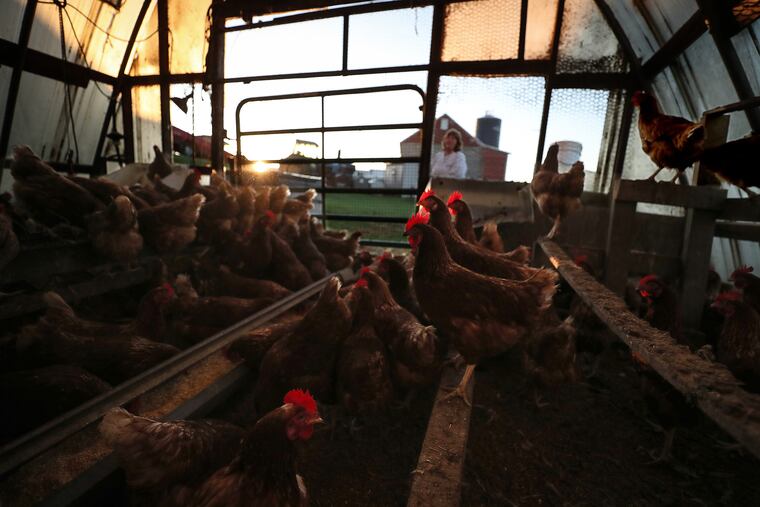Why Pa. could see more chicken farming due to climate change
The Pennsylvania Department of Environmental Protection has released its 2020 climate impacts report, projecting future effects of climate change on livestock, infrastructure, and water quality to support planning to reduce risk to communities and the economy across the state.

Pennsylvania released an updated climate assessment report Monday showing that a continuing rise in temperatures and rainfall could affect everything from the number of chickens farmed to water quality.
The first climate assessment for the state was issued in 2009, with updates in 2013 and 2015. Those reports examined the effects of climate change on agriculture, energy, forests, human health, outdoor recreation, water, and aquatic resources.
The 2015 report showed a 2-degree rise in average temperature, a 10% increase in average annual rainfall, and more extreme precipitation overall since 1901.
The latest report narrows its focus to the projected effects of climate change on livestock, infrastructure, and water quality. The goal is to help communities and businesses plan.
The data were analyzed for the state Department of Environmental Protection by the Pennsylvania State University Environment and Natural Resources Institute.
Pa.’s changing climate
Using federal data, the Penn State scientists projected that all 67 counties will continue to experience warmer and wetter weather. Using a baseline year of 2000, average rainfall and extreme precipitation are expected to increase by 8% to 12%, especially in winter and spring, through the mid-century, defined as between 2041 and 2070. In that same projection, the average temperature is expected to rise by 4.9 degrees Fahrenheit.
The projections assume greenhouse gas emissions continue to grow at a high rate throughout the 21st century. If the rate of emissions slows, projected climate change would be less. Scientists attribute the rise to climate change caused by the burning of fossil fuels since the late 1800s.
“Effective decision-making for Pennsylvania’s future is decision-making that accounts for the changes that are likely to happen if we don’t reduce greenhouse gas emissions, and meets the need to manage them,” DEP Secretary Patrick McDonnell said in a statement.
Gov. Tom Wolf has set a statewide goal of lowering greenhouse gas emissions 80% by 2050.
Changes to livestock farming
The report says dairy, beef, and livestock production is intrinsically linked with climate, since they are dependent on the weather for success, though most poultry and hog production takes place indoors. But indoor facilities have to be heated and cooled, for example, and animals feed on grains that can change in price because of weather and disease.
Those increased costs associated with raising livestock in warmer weather in southern states could stimulate a movement north, the authors state. As a result, Pennsylvania’s poultry inventory could double in size.
Small increases are likely in beef cattle and hog and pig inventories. The dairy cattle inventory is anticipated to remain roughly the same, though where dairy cattle operations take place could change within the commonwealth.
Water quality issues
In addition, large-scale livestock farming also produces large amounts of manure, creating high concentrations of nitrogen and phosphorus, a source of pollution. Any possible increase in that livestock means a greater need for stormwater management to keep the pollutants out of waterways.
Projections for nitrogen and phosphorus from animal manure show increases through 2050 due to climate change. Those changes could produce excess nutrients in waterways, especially in the Susquehanna and Delaware River watersheds.
The Susquehanna is the biggest tributary to the Chesapeake Bay, and Pennsylvania is required to meet water quality goals that reduce the daily pollution load on the bay.
The state has already experienced issues trying to meet those goals, and increased loads in the two nutrients could make that even more difficult.
Threats to infrastructure
Localized intense flooding poses the biggest potential stress on Pennsylvania’s infrastructure for energy, transportation, and water.
The report found no evidence that changes in climate over several decades have made flood situations more common among major waterways. But the damages from flooding have risen because of increased population. That suggests more potential for flooding among smaller waterways that have not seen issues in the past because surrounding areas had been undeveloped.
Patterns of rainfall analyzed by the authors suggest flooding is likely to increase in frequency overall, and possibly in severity, in the coming decades as climate changes.
Heavy precipitation can lead to an increased risk of landslides because of the state’s topography, especially in Southwestern Pennsylvania. Many roads and rail lines follow contours carved out by rivers, so landslides could pose a threat.